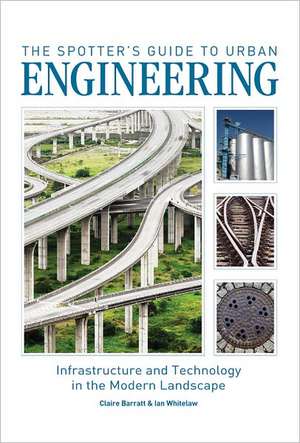The Spotter's Guide to Urban Engineering: Infrastructure and Technology in the Modern Landscape
Autor Claire Barratt, Ian Whitelawen Limba Engleză Paperback – 31 aug 2011
"An illustrated field guide to the technology that keeps our cities and towns working. "
"The Spotter's Guide to Urban Engineering" is a useful identification tool to the mysteries of how our cities are built and work.
Each spread identifies an example of urban engineering and describes what it is, how it works and why it is there. Annotated diagrams explain the technology, and location maps indicate noteworthy real-world examples. Most importantly for spotters, the book gives advice on how to identify these features and tips on where to spot them.
The book covers the main areas of engineering infrastructure. Concise descriptions begin with a brief introduction, a timeline tracing that area's development and a synopsis of facts and figures. More than 300 illustrations and a durable flexibound format allow for easy reference in the field.
The book covers: Managing raw materials, including mining, agriculture, waterworks and manufacturing Making power, including electricity grids, oil and gas extraction and distribution, and renewable energy Transport, including highways, railways, bridges, tunnels, canals and aviation Communications, including telephone, radio, television, satellites and digital technology Waste, including sewers, industrial and residential waste management, recycling.
"The Spotter's Guide to Urban Engineering" provides lay readers with a fascinating introduction to the technology that underpins modern life. Those contemplating a career in civil engineering will find the book of particular interest.
Preț: 147.22 lei
Nou
28.17€ • 29.49$ • 23.31£
Carte indisponibilă temporar
Specificații
ISBN-10: 1554077087
Pagini: 224
Dimensiuni: 170 x 226 x 18 mm
Greutate: 0.64 kg
Editura: Firefly Books
Descriere
"The Spotter's Guide to Urban Engineering" is a useful identification tool to the mysteries of how our cities are built and work.
Each spread identifies an example of urban engineering and describes what it is, how it works and why it is there. Annotated diagrams explain the technology, and location maps indicate noteworthy real-world examples. Most importantly for spotters, the book gives advice on how to identify these features and tips on where to spot them.
The book covers the main areas of engineering infrastructure. Concise descriptions begin with a brief introduction, a timeline tracing that area's development and a synopsis of facts and figures. More than 300 illustrations and a durable flexibound format allow for easy reference in the field.
The book covers: Managing raw materials, including mining, agriculture, waterworks and manufacturing Making power, including electricity grids, oil and gas extraction and distribution, and renewable energy Transport, including highways, railways, bridges, tunnels, canals and aviation Communications, including telephone, radio, television, satellites and digital technology Waste, including sewers, industrial and residential waste management, recycling.
"The Spotter's Guide to Urban Engineering" provides lay readers with a fascinating introduction to the technology that underpins modern life. Those contemplating a career in civil engineering will find the book of particular interest.
Notă biografică
Ian Whitelaw is an author and editor who lives with his family on Vancouver Island, Canada. Ian is co-author of "The Field Guide to Natural Wonders."
Recenzii
For general attention-paying, check out The Spotter's Guide to Urban Engineering, a new book that falls somewhere between the pocket-handy Field Guide to Roadside Technology and the irreplaceable but unwieldy Infrastructure: The Book of Everything for the Industrial Landscape. The Spotter's Guide is sort of the bathroom book that goes between the pocket Field Guide and the encyclopedic Infrastructure. Too big for your pocket yet not overwhelmingly thorough, it's a great place to dip--how do canal locks work? the world's most complicated roundabout? a movable bridge that curls instead of lifting or rotating? It's all here.--Scott Huler"Scientific American" (01/06/2012)
